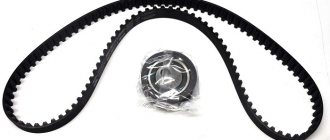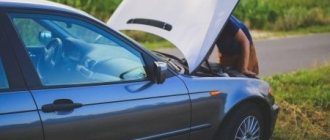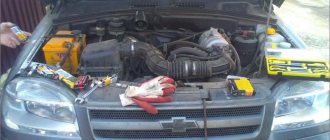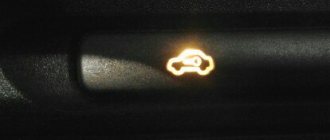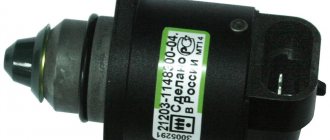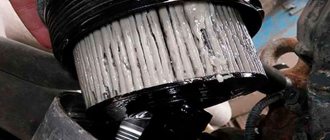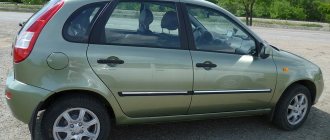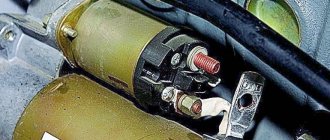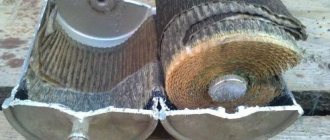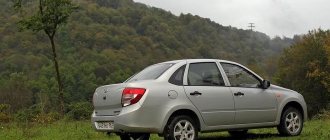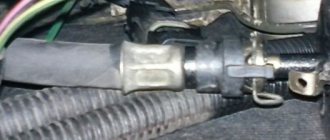Good afternoon, fellow Drayvovites.
I ask you for advice. And the situation is this: initially, nothing foreshadowed trouble. After driving normally for half a day, when parking (I was driving in reverse), the car suddenly stalled. When I tried to start it, something similar happened: after spinning the starter, the engine started, but immediately the speed dropped to 0. Pulling the throttle cable, I eventually managed to start the car and it idled normally.
After that I drove around the rest of the day without any problems starting it many times without any problems.
The next day there were no problems again and after sitting overnight it started without problems many times. But in the evening the same symptoms began and it was no longer possible to start her.
I spin the engine with the starter, it seizes and immediately the speed drops to 0 and everything stalls. If you press on the gas, then after the engine catches, everything works smoothly until you release the gas.
Please help me with advice - what could this be?
In this article we will take a closer look at the situation when a carburetor engine of a passenger car (VAZ 2108, 2109, 21099, 2105, 2107 and their modifications) starts and stalls due to a carburetor malfunction. Malfunctions of carburetors 2105, 2107 Ozone, 2108, 21081, 21083 Solex and their modifications will be considered.
— The engine starts, runs for a few seconds and then stalls; repeated starts are unsuccessful.
— The engine starts with difficulty, after running for a short time it stalls, after restarting it starts and runs.
— The engine starts and immediately stalls, starts again and stalls again, and so on several times, but then it still starts working.
Causes of malfunction
There is no fuel in the float chamber
Pump it up using the manual pump lever on the fuel pump.
The fuel pump or power system may be faulty. Remove the hose from the carburetor fuel supply fitting and press the manual primer lever on the fuel pump several times. A strong pulsating stream of gasoline should come out of the hose hole. If it is missing or weak, check the fuel pump or power system.
VAZ fuel pump check
The strainer at the carburetor inlet is clogged
Remove it by unscrewing the cap, clean it (you can use a toothbrush), rinse with acetone or gasoline and blow with compressed air. At the same time, clean the filter seat in the carburetor cover.
details of mesh filters for fuel purification of carburetors 2108, 21081, 21083 Solex, 2105, 2107 Ozone
The solenoid valve is faulty or the fuel jet of the idle system is clogged
Check whether the solenoid valve or the idle air system fuel nozzle holder has become loose due to any circumstances. Turn it on. Remove the wire from the valve and then put it back on. You should hear the click of the valve being activated. If it is not there, we connect a piece of wire plus the battery and the valve outlet. There is no click - we change the valve. There is a click - we check the EPH system.
carburetor solenoid valves 2108, 21081, 21083 Solex, 2105, 2107 Ozone
Check the serviceability of the valve itself by unscrewing it from the carburetor and removing the fuel jet from it. The jet should be carefully inspected for contamination and deformation. We also check the ease of movement of the valve shut-off needle, the presence and integrity of the rubber O-ring on the valve body.
carburetor solenoid valve device
Unscrew the idle air system fuel nozzle holder (on carburetors with a holder instead of a solenoid valve), rinse, clean the fuel nozzle and blow with compressed air.
“Suction” of foreign air into the carburetor
In this case, the fuel mixture is lean. If the engine starts and immediately stalls, it is most likely very lean. The image shows probable places where foreign air is “sucked in” on the 2108 Solex carburetor.
places where foreign air is likely to “suck” into the carburetor 2108, 21081, 21083 Solex
Renault Logan starts up when cold and immediately stalls: reasons, + video
After a certain period of time, some Renault Logan owners begin to experience an unpleasant feature when using this car. Logan stalls immediately after starting - this is exactly what Logan drivers unanimously say. What is the reason for this behavior? Let's try to figure it out in this article.
Stalls in wet weather
With the onset of autumn and, consequently, an increase in environmental humidity, the engine begins to operate unstably and begins to stall at idle speed. However, it is worth noting that immediately after warming up the problem disappears.
The largest number of experts, answering this question, agree that high-voltage wires and glow plugs become damp, causing all contacts to work when exposed to excess moisture.
In addition, this problem occurs when the ignition coil is faulty and the housing has cracks, into which excess moisture gets in (in the video above, it is worth noting that if a similar problem does not occur in the rain, then this is not the reason).
Stalls immediately after starting
Another problematic issue arises for owners when the car stalls immediately after starting a cold engine. And this is accompanied by a sharp rise in speed at start, followed by a smooth reset of idle speed to 400 rpm, when the engine begins to choke and subsequently stall.
Main reasons
There may be several reasons for this behavior:
- The idle speed control needs to be cleaned (replaced).
The photo shows that the idle air control valve is very clogged.
The throttle valve needs to be flushed.
Clean throttle (throttle assembly)
New temperature sensor
Replacing the air filter with the original one. (A similar problem was observed among Logan owners who used a cheap Chinese analogue.)
How to avoid mistakes when operating a car that lead to battery discharge
- When connecting car heaters, audio/video devices, light sources and other energy consumers to the on-board network, make sure that the generator has sufficient power reserve to power additional devices.
- When sitting in traffic jams for a long time, keep in mind that the generator produces full power only when the engine speed exceeds 1500, and at idle speed the battery carries part of the load, so in such cases it is advisable to disconnect unnecessary energy consumers from the on-board network.
- When operating a vehicle on frequent trips over short distances, the battery does not have time to be recharged from the generator and requires periodic recharging with an external charger.
- The most common causes of discharge are side lights that are not turned off, a constantly burning light in the trunk, an incorrectly connected alarm system.
- Do not use fuses with a higher rating than those specified in the vehicle's operating instructions.
- Protect the terminals from oxidation with special means.
- Keep the HIT clean to avoid self-discharge through the conductive layer of surface contaminants.
- When installing a new battery, be sure to completely remove the protective plastic film - dust and dirt accumulate under it.
- If you are not going to use the car for a long time, do not leave the battery connected to the on-board power supply to avoid complete discharge - this can lead to a significant loss of its capacity due to accelerated sulfation of the plates.
- At least once a year, preferably before the onset of cold weather, recharge the battery with a mains charger in desulfation mode, check the tension of the alternator belt and check the on-board network for leaks.
- Consider the features of operating and storing a car battery in winter.
Proper operation and compliance with storage rules during the cold season, as well as preventive measures, will minimize the risks of unpleasant situations occurring, as usual, at the most inopportune moment.
Chevrolet Niva starts and stalls when cold, what should I do?
Perhaps the reason should be looked under the hood?
After a long period of parking, the engine starts, runs for a few seconds, and then stalls. There may be several reasons for such a malfunction, but let’s imagine that the diagnostic station is 300 km away from us, and we need to find the cause. We proceed as follows.
Looking at the candles
When using spark plugs with cracks, current leaks through the insulator to the spark plug body.
We unscrew the spark plugs and assess their condition.
If the spark plugs are flooded or wet, then there is a possibility that the idle speed sensor did not turn on, the throttle unit sent the wrong signal to the ECU, which in turn sent too much fuel through the injectors.
In addition, a common culprit for a malfunction with such symptoms is the throttle position sensor. With a high degree of probability, the spark plugs could fail.
Listening to the fuel pump
Niva Chevrolet fuel pump under the seat.
There is a possibility that fuel is not supplied to the ramp, and the engine flared only due to the remaining gasoline in the fuel line.
If this version is confirmed, then the engine will no longer start, the fuel pump needs to be repaired, the fine filter or mesh, or the coarse filter on the fuel pump itself must be replaced.
Looking for an air leak
You should look for air leaks under the hood.
Air leaks in the power system can also cause a similar malfunction. A mixture that is too lean at startup will prevent the engine from running after a flash.
To verify this in field or garage conditions, just cover the air intake pipe of the air filter.
Often, air leaks can occur between the filter housing and the throttle assembly; sometimes excess air can enter through the junction of the intake manifold and the block head.
Cleaning the XX regulator
Old idle air control on a Niva Chevrolet.
If, after trying to start again, the car starts, but the speed fluctuates within the range of 1500–2000 rpm, you can safely remove the idle speed control, clean it or change it.
The regulator will also manifest itself in motion, when the car is coasting, the engine may stall or stall frequently, there may be no idle speed at all if the regulator is faulty or completely coked.
We control the MAF (Mass Air Flow Sensor)
Checking the operation of the mass air flow sensor.
If the mass air flow sensor sends incorrect data to the electronic engine control unit, then the fuel supply changes accordingly, according to the data of this sensor. For example, a faulty mass air flow sensor sends data about 40 kg of air at idle, the ECU adjusts the fuel supply, as a result of which we again have flooded spark plugs and the engine refuses to work after starting without a throttle valve.
One of the most obvious symptoms of air flow meter failure is increased fuel consumption, whether at idle, at medium speeds, or under load.
Why does the Niva stall at idle (main reasons)
The Niva stalled immediately after starting, why?
Almost always, if a Niva car does not idle and stalls, the reason for this is contamination of parts, for example:
- The throttle valve, injector or carburetor is clogged.
- The idle relay has failed.
- The idle jets are dirty.
- The fuel pump is dirty.
- The engine ventilation system is clogged.
The car stalls after turning off the starter
A dirty throttle valve is to blame!
It happens that the car does not want to slow down the engine speed when you release the gas pedal or stalls at idle. Basically, the problem here lies in a clogged throttle valve. It might just jam.
This problem can happen if you constantly drive on low-quality gasoline. The damper can become clogged when contaminated air enters.
The problem can be corrected by cleaning the damper . To do this, you need to use a regular carburetor cleaner. It is sold in the store.
You should also pay attention to the clogging of the oil trap in the engine crankcase. In this case, the engine will suffocate from excess gases from the crankcase. As a result, it will not hold idle speed and stall. To eliminate the problem, you should regularly wash the crankcase ventilation filter.
The engine stalls immediately, but then starts
Idle speed regulator.
Here the reason may be in the firmware of the electronic engine control unit. The reason for this may be improperly performed tuning of the power unit. In this case, the engine will operate stably only at high speeds. If they drop below 1,000 rpm, the engine will simply stall. This malfunction can be eliminated by flashing the unit to the factory version of the program.
You should also pay attention to all kinds of sensors in car systems. These are, for example, the idle speed control, the throttle position sensor and others. They need to be checked at stands.
The carburetor is Niva’s problem
Inspection and disassembly of the carburetor.
If a carburetor , then in 4 cases out of 5 it can be the cause of unstable engine operation. The most common problem is that the carburetor is clogged. Although this unit is considered reliable in a car, it should also be cleaned periodically. It must be washed using special solvents that are sold in the store.
Carburetor contamination
The main enemy of the carburetor is low-quality fuel . Dirt and moisture can also get there from the tank. Therefore, it is recommended to regularly change the fuel filter, which is installed in front of the carburetor.
The fuel pump should be cleaned periodically. A mesh is installed on it, which traps debris.
Poor quality or old hoses through which fuel enters the tank are another reason for carburetor clogging. Such parts need to be changed every 10–15 years.
Fuel jet
It should be checked when the car stalls at idle. To check, you need to turn on the ignition and reset the wire from the EMC and reconnect it. A click should be heard. When it is not there, you should check whether voltage is supplied to it. In some cases, you will have to completely replace the part.
Chevrolet Niva starts and stalls
The Chevrolet Niva received an injection engine that was progressive for those times, and with it a whole list of injection problems. The fact is that any engine with an injection power system is controlled 90% by electronics - sensors, controllers, processors. And these elements require a very high-quality elementary base, fine tuning and special care during assembly. If a Chevrolet Niva starts and stalls when cold, there is a possibility that the control electronics system has failed.
Chevrolet Niva starts and stalls when cold, what should I do?
Perhaps the reason should be looked under the hood?
After a long period of parking, the engine starts, runs for a few seconds, and then stalls. There may be several reasons for such a malfunction, but let’s imagine that the diagnostic station is 300 km away from us, and we need to find the cause. We proceed as follows.
Looking at the candles
When using spark plugs with cracks, current leaks through the insulator to the spark plug body.
We unscrew the spark plugs and assess their condition.
If the spark plugs are flooded or wet, then there is a possibility that the idle speed sensor did not turn on, the throttle unit sent the wrong signal to the ECU, which in turn sent too much fuel through the injectors.
In addition, a common culprit for a malfunction with such symptoms is the throttle position sensor. With a high degree of probability, the spark plugs could fail.
Listening to the fuel pump
Niva Chevrolet fuel pump under the seat.
There is a possibility that fuel is not supplied to the ramp, and the engine flared only due to the remaining gasoline in the fuel line.
If this version is confirmed, then the engine will no longer start, the fuel pump needs to be repaired, the fine filter or mesh, or the coarse filter on the fuel pump itself must be replaced.
Looking for an air leak
You should look for air leaks under the hood.
Air leaks in the power system can also cause a similar malfunction. A mixture that is too lean at startup will prevent the engine from running after a flash.
To verify this in field or garage conditions, just cover the air intake pipe of the air filter.
Often, air leaks can occur between the filter housing and the throttle assembly; sometimes excess air can enter through the junction of the intake manifold and the block head.
Cleaning the XX regulator
Old idle air control on a Niva Chevrolet.
If, after trying to start again, the car starts, but the speed fluctuates within the range of 1500–2000 rpm, you can safely remove the idle speed control, clean it or change it.
The regulator will also manifest itself in motion, when the car is coasting, the engine may stall or stall frequently, there may be no idle speed at all if the regulator is faulty or completely coked.
We control the MAF (Mass Air Flow Sensor)
Checking the operation of the mass air flow sensor.
Finding the reason
Having found out which cylinder is causing the engine of a VAZ or a car of another brand to fail, we proceed to further research. You need to remove the spark plug and inspect it for the presence of gasoline. If the contacts are wet, it means either there is no spark, or the mixture is excessively rich or, on the contrary, lean.
If the candle is to blame
Install a known good spark plug and check the operation of the cylinder. If it starts working, you need to change the spark plug; if it doesn’t work, then the reason why the engine is throbbing is something else. We continue to search.
Problems with wiring or ignition distributor
The next thing to look at when there is no spark is the high voltage wiring. It is necessary to check the condition of the contacts and insulation. Are the terminals intact, free of corrosion, and is the insulation free of cracks? So the problem is elsewhere. Is there any damage? Replace the cable and check the performance of the spark plug again.
There is an express way to check high-voltage wires. It is necessary to start the engine, which has started to stall, in the dark - at night or in a windowless box with the lights off. Under such conditions, all breakdowns will be clearly visible in the form of sparks. With such a malfunction, the voltage simply does not reach the spark plug, so it does not spark.
If the wiring is OK, inspect the distributor cap. Due to a malfunction of this device, different cylinders work intermittently in turn. Cracks on the cover are a clear sign that one of the contacts in the ignition distributor has burnt out, so the engine began to stall.
Air intake from outside
If the spark plug is working properly and the discharge is supplied to it as normal, then the problem is in the air-fuel mixture. Sometimes the intake of air from outside dilutes the injection of gasoline to a concentration at which the mixture does not ignite.
The reasons for air getting into the cylinder can be very different: from damage to the intake manifold pipe to depressurization of the cylinder head seals. This is manifested by the fact that the engine stalls at speed and stalls when the load increases.
To fix the problem, you need to replace the damaged duct or seals. It is possible that air is leaking through the cylinder head gasket. You can replace the gasket yourself or contact a specialist.
Spark plug
Problems arise due to the lack of a spark, and may arise due to the appearance of soot and dirt, which prevents the formation of a spark. If there is this deposit or dirt on the contacts, then it is advisable to change the fuel to a higher quality one, and you should also check the condition of the oil supply system, since a malfunction of the sensor that regulates the oil supply leads to the spark plugs splashing. Also, the appearance of oil indicates that there are problems in the cylinders. Therefore, if you see the presence of all the above phenomena, then it is advisable to diagnose the engine in a car service center, and if the reasons for their occurrence are not eliminated in time, this can lead to an expensive replacement of pistons with jet thrusts.
If you systematically use low-quality fuel, a brown coating appears on the spark plugs, and simple cleaning will not help, so it is better to make a complete replacement.
Reasons why Chevrolet Niva does not start
During vehicle operation, both sensors often fail. The reasons for this are different: manufacturing defects, natural life, third-party mechanical damage. Since the equipment cannot be repaired due to the design features, the craftsmen install new ones. The replacement process is not long, the cost of consumables is cheap.
By analogy with the crankshaft sensor, the DTOZH cannot be repaired. The installation is quite simple and straightforward. You can do it yourself without involving service station workers.
To a greater extent, the electrical component of the breakdown. The design of the IAC sensor allows for maintenance, cleaning, and blowing with compressed air. Replacement in case of mechanical damage or deformation.
First of all, you need to remove the cap from the spark plug (any one) and install spark plug A17 DVRM. Holding it with pliers, turn on the starter.
To remove the cap, hold the spark plug by the hexagon (pliers with insulated handles are suitable). It is necessary that the spark plug body touches the “ground”. As a result, you will be able to see a spark. In the case where there is no spark, this indicates:
By the way, a spark “in the air” does not guarantee its presence in the engine. Spark plugs can be faulty, there is a gap violation, etc.
Electricity supply
If the engine turns off while driving, but it is not difficult to start it, then the problem is most likely a faulty power supply. Problems can be caused by several reasons:
If the wires are damp, it is better to replace them along with the battery. If the terminals have poor contact, they need to be cleaned. If the generator does not work, this may be due to the fact that the timing belt has broken or there is a malfunction inside the generator itself. A problem with the generator on a Chevrolet Niva is easily determined using the indicator on the dashboard. In addition, if the energy supply is insufficient, the backlight of the car’s dashboard will be weak, and the sensor values will be incorrect.
Auto parts for foreign cars, auto repair
You can check it by installing a working relay. You can determine the lack of contact on the main components of car parts by visual inspection. It is necessary to tighten the contacts on the starter, the injector power supply and the fuel pump. The positive wire that powers the electronic injection system comes directly from the battery terminal with a separate wire. Often the problem with the immobilizer can be a low battery. You just need to install a new battery.
This is to clarify the Chevrolet Niva is difficult to start when cold due to a fault in the electrical part of the car, but do not forget about mechanical damage: The indicator on the instrument panel will help you find out if there is no fuel in the tank.
If the fuel gauge is at zero and the warning light in the form of a gas pump is on, then the source of the trouble has been detected and there is no need to open the hood. You can determine if a filter or fuel pump is faulty by hearing.
If you hear a loud buzzing sound in the rear trunk area, the filter or pump is most likely clogged, preventing fuel from getting to the engine. It indicates any damage to the injector or engine error. If the oil level in the car has dropped, this can be determined visually using a warning lamp in the form of a can on the instrument panel. If your Chevrolet Niva doesn't start well when it's cold, make sure there is enough oil in the engine, pull out the level meter and check.
Troubleshooting Having identified the problem that causes the Chevrolet Niva engine to start poorly, you can begin to fix the problem. Knowing the source of the problem, you can draw the appropriate conclusions: Most of the above reasons have a simple nature of damage, and fixing a Chevrolet Niva that doesn’t start well when cold won’t take much time.
A list of the main malfunctions when the engine does not start or starts poorly, and how to eliminate them. You can light a cigarette from another car, then the generator will recharge the battery. Clean the contacts if they are oxidized and lubricate them with Lithol. The lubricant prevents the appearance of oxide on the terminals. Tighten the terminals well to get good contact. Starter Check the starter contacts and tighten them.
In the case of a Chevrolet Niva, it is difficult to start when cold, have the starter repaired to rewind the windings, or install a new one.
Spark plugs Replace all 4 spark plugs with new ones, or clean them with sandpaper. But in any case, if the spark plugs have worked out, they need to be changed so that there are no problems with the engine.
Refuel only at branded gas stations, and only with fuel that is suitable for this type of engine A Fuses Install new fuses.
Sensors
Trouble-shooting
Having identified the problem that causes the Chevrolet to start poorly, you can begin to fix the problem. Knowing the source of the problem, you can draw the appropriate conclusions: are you able to fix the error yourself, without requiring additional help? Most of the above reasons are of a simple nature of damage, and correcting them will not take much time. For the convenience of solving the problem that causes the Shevik to not start, information on how to eliminate them is written in tabular form.
Drivers often encounter the problem of poor engine starting in winter, during periods of severe frost. These frosts damage not only the battery, but also all parts where water may have entered. This problem is also often encountered in extreme heat, when the engine overheats and then has difficulty starting.
Now knowing why the Niva Chevrolet may not start, you can easily go looking for a problem. Having identified the breakdown, you will solve the problem of poor engine starting by 50%. And the solutions are now known, so you can hit the road.
components of electrical equipment for a Chevrolet Niva car. Sometimes, in order to find the cause of a breakdown, you have to check all the components one by one. However, the experience of car enthusiasts allows us to identify the most vulnerable elements that cause the malfunction.
- The battery is low. It may fail due to long service life.
- Starter malfunction.
- Lack of contact at the battery terminals.
- Lack of spark (malfunction of spark plugs, power wires, ignition module).
- Fuse blown.
- Ignition switch malfunction.
- Errors in the immobilizer operation.
READ VAZ 2110 Injector Doesn't Start 8 Reasons
Fuel supply
It is very easy to understand that the reason that the car stalls due to choking of the fuel mixture is that if you drive for a long time, the signal that is responsible for this function will begin to constantly turn on. This problem is associated with low quality fuel, since the spark from the candles is not enough to quickly ignite it. Another reason that the Chevrolet Niva stalls may be:
There are minor interruptions in the power supply to the fuel pump
The presence of these problems leads to the fact that the engine power decreases and it begins to stall.
How to troubleshoot problems on a Niva Chevrolet
| Sign | Elimination |
| The starter rotates but the flywheel does not move. | Wear of flywheel teeth cannot be prevented. Installing a new |
| The starter rotates very slowly and engages intermittently | Low battery voltage. Recharging, replacement. |
| The starter does not turn over in cold weather | The battery is severely discharged and has become unusable. Installing a new |
| The engine starts the second and subsequent times when cold. | Unstable supply of current, spark, fuel. It is necessary to comprehensively check the fuel system, as there can be many reasons |
| The engine takes a long time to start when hot and then immediately stalls. | Clean the throttle valve, check the fuel filter, fuel pump |
| The immobilizer lamp lights up on the dashboard, indicating a breakdown in the power system. | Check the tension of the drive belt, the reliability of the generator, contacts, terminals |
| When starting the engine, a metallic grinding or creaking noise is heard. | Most likely the shaft bearing is worn out, the spring is deformed, the flywheel teeth are damaged |
Regardless of the type of breakdown or the availability of technical equipment maintenance skills, use the services of a service station, where they provide a quality guarantee for the work performed.
Independent intervention in repairs does not always bring positive results. Use the services of handicraft workshops less often.
Chevrolet Niva won't start
It often happens that all standard units are working properly, but the engine does not start. At the same time, the error indicator on the “Check” dashboard does not light up.
It is extremely difficult to immediately name the most likely reason, since there can be at least a dozen of them. It is not advisable to try to find and fix a breakdown on your own without experience. It is better to contact a professional workshop.
Reasons why Chevrolet Niva does not start
- Crankshaft, camshaft position sensor
During vehicle operation, both sensors often fail. The reasons for this are different: manufacturing defects, natural life, third-party mechanical damage.
Since the equipment cannot be repaired due to the design features, the craftsmen install new ones. The replacement process is not long, the cost of consumables is cheap.
- Coolant temperature sensor
By analogy with the crankshaft sensor, the DTOZH cannot be repaired. The installation is quite simple and straightforward. You can do it yourself without involving service station workers.
- Idle speed sensor
To a greater extent, the electrical component of the breakdown. The design of the IAC sensor allows for maintenance, cleaning, and blowing with compressed air. Replacement in case of mechanical damage or deformation.
Spark plugs Niva Chevrolet
Unstable spark plug operation and untimely spark supply contribute to engine detonation. First signs:
- Reduced acceleration dynamics,
- Increased fuel consumption,
- The engine is not running properly
- Difficulty starting the engine.
Since candles are a disposable consumable, they cannot be prevented.
Voltage blocking alarm
Modern security systems fully control the car, its elements and assemblies. In emergency situations, the alarm will prevent theft, but the alarm may be false.
The reasons for the “false call” are caused by:
- manufacturing defects,
- short circuit in the circuit,
- malfunctions in the operation of the electronic control unit,
- damage to electrical wiring, insulation,
- poor terminal contact.
In order to be able to start the car in the future, you need to deactivate the alarm. However, you need to know what to turn off. To carry out work at a professional level, visit a service station.
Battery Niva Chevrolet
Due to insufficient battery charge, the starter does not rotate, the flywheel does not spin, and the combustible mixture in the combustion chamber does not ignite. To check the battery charge level, you need to use a multimeter.
Based on the results obtained, make a decision on the advisability of further use of the battery. The average battery life is 5 – 6 years, after which it needs to be replaced with a new one.
Lately it has become popular to buy gel batteries. Instead of the usual electrolyte, the compartments are filled with gel. The service life of batteries of this class is 25% longer than analogues.
Supply system
The main task of the fuel filter is to timely supply fuel to the combustion chambers. It is difficult to physically check the flow of fuel to the ramp without special equipment.
First, we check the flow of fuel through the filter. The presence (absence) of fuel will be visible through the transparent body. We replace the cleaning element with a new one as needed.
We check the limit switches, terminals on the contacts, injectors, and fuel pump. We clean, remove oxidation, tighten the clamps. We check the fuel pump for serviceability by turning the key in the ignition. A clicking sound is heard from the fuel pump. If there is none, then there is a malfunction in the “pump”.
You can verify the presence of fuel in the fuel rail, and also measure its pressure with a pressure gauge. Similar equipment is available in service centers and workshops.
Glow plugs
The engine does not start in the cold - the first sign of failure of the spark plugs. When in good condition, candles heat the space from the inside. In the event of a breakdown, starting the engine is complicated by low temperatures and the formation of condensation.
We check the spark plugs with a multimeter and replace them with new ones as necessary. We also inspect the spark plug start relay. It should make a slight clicking sound.
The method described above is effective for the injector. In the case of a carburetor, the checking mechanism is as follows:
- open the hood, wait until the engine cools down to a safe temperature,
- remove the cradles one by one, unscrew the spark plugs, check them for the presence of a spark,
- install new spark plugs, replace them if defective ones are found,
- assembly in reverse order.
Air lock in the fuel line of Niva Chevrolet
The intake of air into the fuel circuit from the outside creates plugs, as a result of which the fuel mixture does not burn in full. A copious amount of carbon deposits is formed, which settles inside the exhaust system and exhaust manifold.
Carbon deposits clog the catalyst, which reduces power, increases fuel consumption, and exposes the engine to unstable idle speed.
You can remove air from the system by connecting a rubber hose to the “return” and grinding off the fuel until the air is removed. Subsequently, the fuel can be reused.
Tips for care and maintenance of Niva Chevrolet
- Observe technical inspection intervals every 20,000 km,
- Buy original parts with factory catalog numbers. Avoid buying cheap analogues of dubious origin,
- During the warranty period from the manufacturer, visit a service station to undergo routine diagnostics with a note in the service book,
- Remember that the length of its service life depends on the driving style of the car,
- Observe the timing of the transition to the summer/winter tire seasons, check the tire pressure.
How to troubleshoot problems on a Niva Chevrolet
| Sign | Elimination |
| The starter rotates but the flywheel does not move. | Wear of flywheel teeth cannot be prevented. Installing a new |
| The starter rotates very slowly and engages intermittently | Low battery voltage. Recharging, replacement. |
| The starter does not turn over in cold weather | The battery is severely discharged and has become unusable. Installing a new |
| The engine starts the second and subsequent times when cold. | Unstable supply of current, spark, fuel. It is necessary to comprehensively check the fuel system, as there can be many reasons |
| The engine takes a long time to start when hot and then immediately stalls. | Clean the throttle valve, check the fuel filter, fuel pump |
| The immobilizer lamp lights up on the dashboard, indicating a breakdown in the power system. | Check the tension of the drive belt, the reliability of the generator, contacts, terminals |
| When starting the engine, a metallic grinding or creaking noise is heard. | Most likely the shaft bearing is worn out, the spring is deformed, the flywheel teeth are damaged |
Regardless of the type of breakdown or the availability of technical equipment maintenance skills, use the services of a service station, where they provide a quality guarantee for the work performed.
Independent intervention in repairs does not always bring positive results. Use the services of handicraft workshops less often.
Similar:
- Skoda Fabia will not start Skoda Fabia will not start When operating a Skoda Fabia, breakdowns periodically occur, some of which can make it impossible to start the engine. If.
- Porsche Cayenne will not start In order for the Porsche Cayenne engine, like any other internal combustion engine, to start, several conditions must be met: the starter spins the crankshaft to the required speed, there is a spark in the cylinders.
- Lada Priora will not start Lada Priora is a popular Russian car, which, since its appearance, has been actively popularized among car enthusiasts in our country. It is also important that manufacturers pay close attention.
- Nissan Primera won't start The Nissan Primera is a reliable car, but despite this, the risk of the engine being unable to start still exists. The reasons for this problem can be very different. Part.
Exhaust system
If the tubes that remove gas fail, this leads to the fact that the car begins to choke while driving, stopping the engine completely. The problem usually occurs for two reasons:
If these problems occur, you should clean the muffler, check the catalyst and, if necessary, replace it.
It is important to pay attention to the prompts that the on-board computer gives; if there are errors in a particular system, they should be corrected immediately. If these problems are minor and mechanical in nature, then you can fix them yourself, but if the failure is related to electronics, then it is better to carry out diagnostics in a specialized car service center.
Symptoms of a problem
- When such a problem occurs, the engine with a carburetor “troits”, often stalls, and a loss of power is also felt. Fuel from the “broken” cylinder enters the exhaust system. The smell of fuel, characteristic pops and shots in the muffler indicate the presence of misfires.
- If the engine is fuel-injected, the malfunction can be easily noticed by similar signs and noticeable shaking of the car. Additionally, the error is stored in the memory of the electronic control unit and is displayed as a special “check” icon on the dashboard. Sometimes the system automatically turns off the fuel supply to the “conflict” cylinder.
Spark plug
Problems arise due to the lack of a spark, and may arise due to the appearance of soot and dirt, which prevents the formation of a spark. If there is this deposit or dirt on the contacts, then it is advisable to change the fuel to a higher quality one, and you should also check the condition of the oil supply system, since a malfunction of the sensor that regulates the oil supply leads to the spark plugs splashing. Also, the appearance of oil indicates that there are problems in the cylinders. Therefore, if you see the presence of all the above phenomena, then it is advisable to diagnose the engine in a car service center, and if the reasons for their occurrence are not eliminated in time, this can lead to an expensive replacement of pistons with jet thrusts.
If you systematically use low-quality fuel, a brown coating appears on the spark plugs, and simple cleaning will not help, so it is better to make a complete replacement.
Air lock in the fuel line Niva Chevrolet
The intake of air into the fuel circuit from the outside creates plugs, as a result of which the fuel mixture does not burn in full. A copious amount of carbon deposits is formed, which settles inside the exhaust system and exhaust manifold.
Carbon deposits clog the catalyst, which reduces power, increases fuel consumption, and exposes the engine to unstable idle speed.
You can remove air from the system by connecting a rubber hose to the “return” and grinding off the fuel until the air is removed. Subsequently, the fuel can be reused.
- First of all, for all types and models of cars, you should pay attention to the battery - it can be worn out or simply discharged.
- The starter has become wet or has become unusable.
- The terminals may have oxidized, resulting in poor battery contact.
- Malfunctions are often due to defects in spark plugs, which occur when using low-quality fuel. Also, the spark plugs could simply wear out, forming a large gap.
- Another reason is a blown fuse.
- Broken ignition relay.
- It is possible that the wire supplying the starter or injector has been torn off.
- The immobilizer is not working.
- The most common reason is the lack of fuel in the gas tank. This can happen due to driver inattention or sensor failure.
- Another reason is a clogged fuel pump or fuel filter.
- The injector may become clogged.
- The engine overheats if there is not enough oil in it or if the oil in the radiator is too low.
- The idle air control valve may be damaged.
READ Did our spies spot the Volkswagen ID.4 GTX Performance model?
Electricity supply
If the engine turns off while driving, but it is not difficult to start it, then the problem is most likely a faulty power supply. Problems can be caused by several reasons:
If the wires are damp, it is better to replace them along with the battery. If the terminals have poor contact, they need to be cleaned. If the generator does not work, this may be due to the fact that the timing belt has broken or there is a malfunction inside the generator itself. A problem with the generator on a Chevrolet Niva is easily determined using the indicator on the dashboard. In addition, if the energy supply is insufficient, the backlight of the car’s dashboard will be weak, and the sensor values will be incorrect.
Fuel supply
It is very easy to understand that the reason that the car stalls due to choking of the fuel mixture is that if you drive for a long time, the signal that is responsible for this function will begin to constantly turn on. This problem is associated with low quality fuel, since the spark from the candles is not enough to quickly ignite it. Another reason that the Chevrolet Niva stalls may be:
There are minor interruptions in the power supply to the fuel pump
The presence of these problems leads to the fact that the engine power decreases and it begins to stall.
Messages [1 to 25 of 165]
1 Topic from Sanya123 08/12/2012 15:58:03
- Sanya123
- Participant
- Inactive
- From: Krasnodar, YMR
- Registered: 11.08.2012
- Messages: 282
Topic: Niva starts and stalls
Today I was driving and suddenly I felt that the cravings began to disappear sharply. After 300 meters I went fine. After a couple of kilometers I got up. When I start it, it starts with half a turn, responds perfectly to the gas, and literally after a couple of seconds it gradually stalls. Moreover, before stalling, it runs for some time at very low speeds. It stalled. I start it right away and everything repeats. It feels like it's running out of gas. Niva 21214 distributed injection.
Exhaust system
If the tubes that remove gas fail, this leads to the fact that the car begins to choke while driving, stopping the engine completely. The problem usually occurs for two reasons:
If these problems occur, you should clean the muffler, check the catalyst and, if necessary, replace it.
It is important to pay attention to the prompts that the on-board computer gives; if there are errors in a particular system, they should be corrected immediately. If these problems are minor and mechanical in nature, then you can fix them yourself, but if the failure is related to electronics, then it is better to carry out diagnostics in a specialized car service center.
Why does the Chevrolet Niva start and immediately stall when it’s cold?
It is better to visit an auto electrician to determine the root cause of the failure of the fuses. Ignition relay Replace with a new relay. Broken wire of the main components Having found out which wire is broken, you need to find out the reason why this happened. After that, install it in place.
Reasons why Niva 4x4 does not start (the starter does not turn)
Immobilizer Anti-theft system suffers from battery failure. There may be several reasons for such a malfunction, but let’s imagine that the diagnostic station is miles away from us and find the cause. We proceed as follows.
We look at the spark plugs When using spark plugs with cracks, current leaks through the insulator to the spark plug body. We unscrew the spark plugs and assess their condition. If the Chevrolet Niva spark plugs do not start well when they are cold or wet, then there is a possibility that the idle speed sensor did not turn on, the throttle unit sent the wrong signal to the ECU, which in turn supplied too much fuel through the injectors. In addition, a frequent culprit of Chevrolet Niva malfunctions is that it is difficult to start when cold; such symptoms are the throttle position sensor.
With a high degree of probability, the spark plugs could fail. Listening to the fuel pump Turn on the ignition and listen to see if the fuel pump is working. The battery voltage is within normal limits. The relay is checked with an ohmmeter or if it is overheated. Replace the starter solenoid relay. Burnt starter commutator, stuck brushes or severe wear. The starter does not turn or turns slowly.
With the starter removed, check the pressing force of the brushes to the commutator, their residual height, wear and tear. Chevrolet Niva does not start easily when cold. Repair the starter. If the commutator is severely worn, replace the starter. Break or short circuit in the starter armature winding. The starter does not rotate or rotates slowly. The serviceability of the winding is checked with an ohmmeter or by darkening of the insulation. Replace the starter. The starter spins, but the flywheel is motionless. Replace the clutch or starter. The ring gear rotates on the flywheel. The starter rotates, but the flywheel and crankshaft are motionless.
Chevrolet Niva doesn't start well
Every owner of a vehicle experiences situations where you are in a hurry to go to work in the morning, get behind the wheel of your car, and then the unexpected happens - the car does not start. All car owners know what an unpleasant situation this is.
To solve this problem, it is necessary to find out the reason, and what could be the reason in such a car, with a large number of different parts? Even experienced car owners sometimes ask this question. After all, you will never guess which part has failed and how to eliminate this reason.
In order to understand this issue, we will consider all the sources of malfunctions in the Chevrolet Niva, how to identify them correctly, what is necessary to resolve them and why this happened.
To troubleshoot a car problem, you first need to find out the source why the car won’t start. The driver can be helped in identifying damage by various sensors on the instrument panel, an external inspection of the car, or the sound that is made when the key is turned. So, the main problems that cause the engine to start poorly and the car will not start may be the following malfunctions.
Causes of electrical damage:
Mechanical faults:
How to find out the cause of the problem
Knowing the most common sources for which the Chevrolet Niva does not start well, now you need to find out how to correctly determine the damage? After all, there are many reasons, and it will take a considerable amount of time to check all this. Finding out the reason why your iron horse does not want to work is done with the help of your eyes, ears and car tips.
You can call a technician to your home, who will determine the damage in a matter of minutes, and sometimes even seconds. And for this clarification, you will have to pay a lot of money. You can take your car to a service station by asking a friend to help with transportation. It will cost much less than calling a technician to your home, but you will spend a lot of time. Therefore, your best bet for determining damage is you and your head.
Only if all possible reasons have been verified, then it is necessary to contact a specialist. Perhaps your car requires a major check of the entire system.
Knowing all the shortcomings why the Niva does not respond to turning the key in the ignition, you can easily identify them:
This is to find out the reasons for the malfunction of the electrical part of the car, but do not forget about mechanical damage:
The car won't start - 5 most common reasons
Imagine getting into your car in the morning to go to work.
And suddenly the car won't start. This situation can confuse many drivers. Why did this happen if everything was fine yesterday? We've collected the 5 most common reasons why a car won't start and told you how to diagnose and fix the problem.
